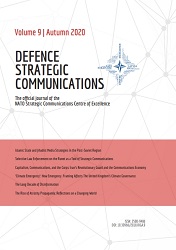ISLAMIC STATE AND JIHADIST MEDIA STRATEGIES IN THE POST-SOVIET REGION
ISLAMIC STATE AND JIHADIST MEDIA STRATEGIES IN THE POST-SOVIET REGION
Author(s): Ian MacWilliamSubject(s): Media studies, Political history, Islam studies, Government/Political systems, Politics and communication, Politics and religion, Radical sociology , Post-Communist Transformation
Published by: NATO Strategic Communications Centre of Excellence
Keywords: strategic communications; strategic communication; Islamic State; violent extremism; radicalism; jihad; disinformation; Central Asia; Caucasus; Russia; post-Soviet;
Summary/Abstract: The Syrian war is the first of the modern Islamist “jihad” conflicts to have attracted large numbers of recruits from Central Asia and the post-Soviet region. Some 9,000 men and women from the post-Soviet republics travelled to Syria, including 4,000-7,000 Central Asians, many of them recruited in Russia. Why did the Islamic State’s caliphate attract such large numbers? Information manipulation was central to IS strategic planning and a primary factor in its unprecedented global recruiting success. IS produced Russian-language media content to build support among post-Soviet Muslims. At the same time, emerging communications networks are building ties between “Russianspeaking” Muslims and the Middle East. Jihadist media engagement in Russian and in Central Asian languages, exploiting these new networks, was a key factor in attracting Central Asians to support the caliphate.
Journal: Defence Strategic Communications
- Issue Year: 9/2020
- Issue No: 9
- Page Range: 15-51
- Page Count: 37
- Language: English

